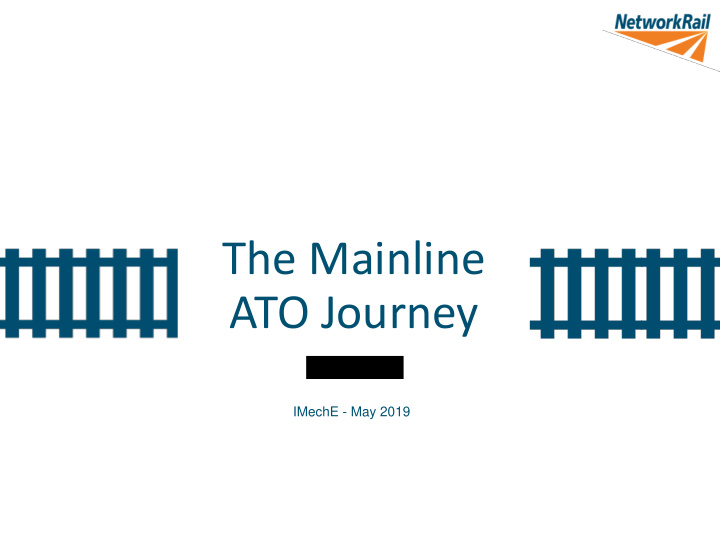



The Mainline ATO Journey IMechE - May 2019
Mainline ATO over ETCS development CR1238 - ATO B3 R2 TEN-T PROGRAMME 2011- 2014 2
ATO Development Projects S2R IP2 ‘Advanced Traffic Management and Control system’ NGTC Learning from CBTC how to develop ATO Common ATO Requirements TEN-T ATO system S2R IP5 ‘ Technologies for sustainable and attractive European rail development freight’ ATO Ops Concept T5.6 Autonomous train operation 3
ATO/C-DAS Road Map 2016 2021 GoA2 Road Map (including C-DAS) ATO GoA2 ATO GoA2 GOA2 Pilot Line Prototype Architecture Demonstration Development Definition (at Watton-on- Stone) GOA2 Reference ATO GoA2 Test Bench Specifications CCS TSI Demonstration (incl. DMI specs update to (at ENIF) for C-DAS) include ATO ATO GoA3/4 ATO GoA3/4 GOA3/4 Pilot Feasibility Prototype Line Study Development Demonstration GOA3/4 ATO GoA3/4 ATO GoA3/4 Reference Test Architecture Specifications Bench Definition Demonstration GoA3/4 Road 2016 2025 Map 4
What is ATO? • Automatic driving of the train to meet the (real time) operational timetable in the most energy efficient way. • Grades of Automation: • GoA 1 - Manual Train Operation (including C-DAS) • GoA 2 - Driver-attended Automatic Train Operation. • GoA 3 - Driverless Train Operation • GoA 4 - Unattended Train Operation 5
Benefits of ATO More Better Greater Trains Connections Reliability • Increased capacity on the existing network • Increased energy efficiency • Improved recovery from disruption (better punctuality) • Reduced operational costs • Reduced wear and tear due to reduced traction/braking and overall lower running speeds • Train regulated to real time operational data, fewer restrictive signals (and less stopping of the train) • Train stops automatically in station, no missed stations • Support for improved conflict resolutions (TMS) • Improved passenger comfort 6
Key requirements for the ATO over ETCS System There are 4 key areas: • Legislation Interoperability (ATO in the CCS TSI) ▪ Optional function (Mandatory specifications) ▪ • Levels & Modes C-DAS system in GoA1 ▪ ATO/C-DAS shall be possible in ETCS Level 1, 2 & 3 ▪ New ETCS mode (AD mode) ▪ 7 7
Key requirements for the ATO over ETCS System • Integrated DMI Integrating ATO/C-DAS display with the ETCS ▪ DMI No additional train data entry for ATO ▪ • Architecture Integrated ATO/ETCS on-board ▪ Fully separate ATO on-board (FFFIS ATO/ETCS ▪ on-board) Packet Switching communication only ▪ Separate ATO communication session ▪ 8 8
Hybrid ETCS Level 3 ATO over ETCS Train Integrity Monitoring Indicates completeness with reported length Journey/Segment profile ‘Signalling Movement authorisation Centre’ Train/position information TIM Operational Status Report ETCS-onboard position Driver interface information ATO onboard TC Joint/ axle counter ijken positie position reference 9
ATO over ETCS Reference Architecture 10
How does ATO over ETCS work? Fully Real time update of operational data protected by ETCS Real time update of infrastructure data ATO-OB drives train to most energy ATO optimizes efficient speed profile to meet the speed for energy saving timetable Station C Station B Station A Traffic Management Radio Block System Centre 1 1
Thameslink ATO Concept Train-Control Conceptual Diagram Wide Area Connection GSM-R Traffic Management System Interoperable Wide Area Radio Block ETCS Comms Connection Centre Interlocking Processor (Packet 44 for ATO comms) GPS GSM-R ATP – ATO GPS Data (could be integrated or 00:07 separate units) Geospatial DMI ATO Positioning Door GSM-R ATP Platform Control Data (EVC) Count-Down Clock BTM Train Detection System TPWS Traction Eurobalise AWS Control ETCS Comms Brakes STM (Packet 44 for ATO comms) Version: 8.0 Date: 19/1/09 12
Thameslink/Crossrail ATO Lessons Learnt Timetable Construction Current 30 second timing resolution introduces challenges. ▪ For ATO to work effectively requires more detailed timetable ▪ information & ideally real time updates Definition, location & alignment of timing points between ▪ timetable production systems and ETCS/ATO balise groups. Door Opening and Door Closing Need to be considered from an operational perspective ▪ Train dispatch arrangements Alignment of driver dispatch procedures with timetable ▪ departure times. 13
Thameslink/Crossrail ATO Lessons Learnt Station Stopping Positions Thameslink uses a ‘centre line’ stopping strategy for ▪ variable length trains Crossrail will operate with platform screen doors and ▪ fixed length trains Transition arrangements need to be considered Relationship between ETCS and ATO transitions ▪ Storage and update of the ATO Track Data Base. On-board data base as on Thameslink ▪ Dynamic update of train from trackside data base as in ▪ European – final choice for Interoperable specifications. Train propulsion and braking systems interface Optimised off site but required fine tuning ▪ 14
Thameslink – ATO & ETCS in the Class 700 Cab 15
16 ATO – Development Roadmap 2009 2009 : Thameslink development of ATO over ETCS starts Oct 2011 – ATO TEN-T Project started 2011 Mar 2012 - Network Rail ATO over ETCS Feasibility Study published 2013 Sept 2013 – First version of ATO over ETCS Operational Concept (up to GoA4) Sept 2013 – NGTC Project started 2014 Dec 2014 – First version of ATO over ETCS System Specification TEN-T project 2016 Mar/Apr 2016: Thameslink ATO tested at ENIF Sept 2016: Shift2Rail (X2rail-1) continues TEN- T work on ATO over ETCS specifications Feb 2017 – NGTC System specifications March 2018 : Thameslink runs ATO in 2018 completed passenger service (world first) May 2018 : First European ATO over ETCS May 2018 : L3 Hybrid ATO demonstrator at specifications agreed by ERA for early ENIF implementers TBD: Interoperable ATO deployed 1 6
Recommend
More recommend